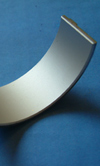Lead-free bearing materials (continued)
 In previous articles about the differences between leaded and lead-free bearing shell materials, several reservations about the latter have been discussed, one of which is the heat transport from oil through the bearing shell to the crankcase, where leaded bearings are said to have the advantage. In this article, I want to offer further insight into the temperature differences between the two materials.
In previous articles about the differences between leaded and lead-free bearing shell materials, several reservations about the latter have been discussed, one of which is the heat transport from oil through the bearing shell to the crankcase, where leaded bearings are said to have the advantage. In this article, I want to offer further insight into the temperature differences between the two materials.
The data here is to be read as relative between the two materials: due to the differences between the several racing classes, absolute figures cannot be given, although the information provided can be taken as representative. I am sure though that a fair number of race engineering colleagues would have more detailed information on their specific applications, which hopefully they are willing to share.
The temperature in the bearings is very difficult to measure directly. The most direct approach is to measure the temperature of the bearing shell in its main bearing bore using thermocouples. It is assumed that a temperature delta of about 5-10 C between the bearing back and the bearing surface exists.
The long-term stability of regular oils is secured until about 140 C. As the last link after the main bearing in the oil feed chain, the con rod bearings will see oil temperatures about 10 C higher, and based on this the maximum oil temperature limits in the main oil gallery can be determined.
The next step is to declare the variables on which the bearing temperatures need to be mapped. In this particular case, oil pressure and rpm are taken as variables, against which the temperature data is investigated. Some factors need to be taken as constant, to be able to predict the isolated differences on the parameters under investigation. In this case, the main gallery oil temperatures were kept constant (controlled by coolant temperature). Clearly, oil specification is another important factor, so this is kept constant by using one oil specification throughout the measurements.
Initially, leaded bearing shells were built into the engine, and bearing shell contact temperatures recorded during an rpm sweep. A significant temperature rise with increased rpm was observed: over a 50% rpm rise, a temperature rise of 10 C was measured. Rpm range was in the higher regions of the total rpm band.
Interestingly, not all the bearing shells showed the same temperature rise coefficient. This confirms that bearing loading can be considered as the major factor in temperature rise. The rpm rise is the same for all bearings, which assumes the same temperature rise coefficient over all of them.
In this particular engine, main bearing no 4 has the highest load, hence the coefficient was higher at this bearing than the others. In this case the difference between coefficients was a factor of two between the main bearing with the highest and lowest loading. Also, the measurements showed that the temperature within a single bearing could differ significantly between the front and rear of the bearing shell (looking in driving direction of the engine) - up to 6 C difference could be measured at one engine load.
Subsequently, the trade-off between oil pressure and bearing temperature was measured, where the oil pressure was reduced using an external oil pump. The goal was to validate the assumption that oil pressure is not a factor in oil temperature, while oil volume is. The pressure build-up is a characteristic of the hydrodynamic bearing itself, so long as enough volume is provided to the bearing. What was learnt from this test is that even a reduction in the oil pressure of about 50% led to a temperature rise of only 3 C on the main bearing temperature, which is negligible.
After these first tests on leaded bearing shells, the engine bottom end was dismantled and lead-free bearings installed, and the same test protocols carried out to determine the difference between leaded and lead-free under standardised conditions.
From these measurements it emerged that only a very small difference in bearing shell temperatures between leaded and lead-free bearing shells is to be expected. Temperature differences were not consistent between the different main bearings over the total rpm band range, but in summary a difference of about 2-3 C was measured.
In conclusion, these results lead back to the initial statement that no significant difference can be observed on bearing temperature between leaded and lead-free bearing materials. I acknowledge that these results might not be representative for all engines in all race applications, but I do feel they show that leaded bearings are not necessarily a must for racing, and that lead-free alternatives are up to the job.
As mentioned earlier, I would be very interested in any data-supported feedback from professional race engineers working in this area.
Fig. 1 - MAHLE Clevite bearings (Courtesy of MAHLE Clevite)
Written by Dieter van der Put